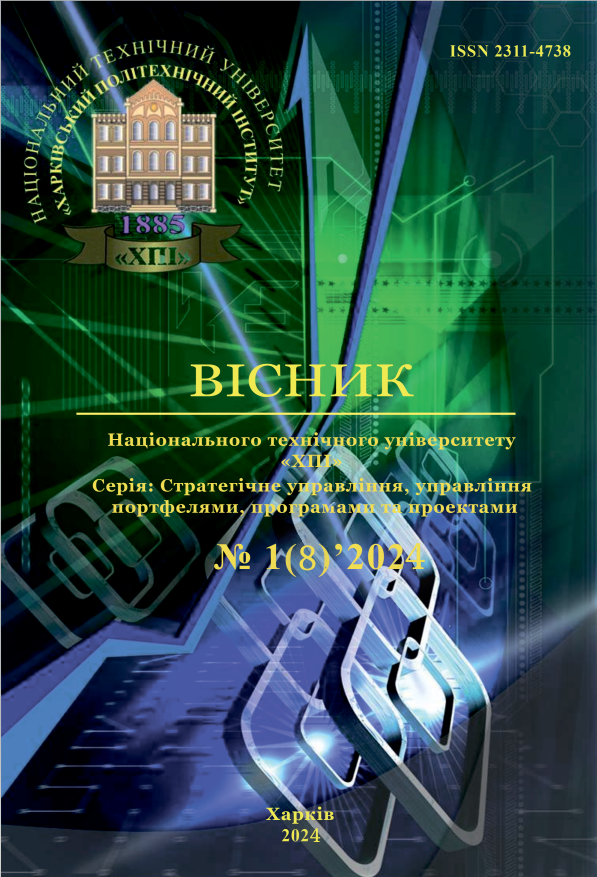PROJECT ACTIVITIES MODELING OF SUPPLY CHAIN STRATEGIES
DOI:
https://doi.org/10.20998/2413-3000.2024.8.8Keywords:
strategy, life cycle, risks, project, supply chain, participantsAbstract
The work is devoted to the consideration of the information system components, which can be used for effective organization and This study is devoted to the reseach of supply chain strategies in project activities. Considered strategies for supply chains, through which better customer service will lead to increased supplies and reduced costs, will bring benefits to all supply chain stakeholders. An illustrative example of a long-term project in the supply chain is provided - the project of the ship acquisition. The ship's life cycle is specified from the standpoint of various participants involved in fleet renewal (replenishment) project. Analyzing each phase of the shipping company's life cycle, risks are examined for each phase of the life cycle, including strategic, economic, commercial, credit, informational, ecological. Alternative supply chain strategies are identified. Taking into account the main objectives of supply chain management, a hybrid strategy can be identified that uses both lean and flexible supply chains. When implementing such a strategy, it is possible to reduce the total order fulfillment time; ensure reliability, correct frequency of delivery, quality and flexibility of delivery; optimize inventory levels throughout the supply chain and minimize total costs. Phases of the life cycle of a supply chain management project are highlighted, as the relationships and obligations between various stakeholders require the construction of a flexible supply chain. Such a supply chain involves solving a series of tasks to meet the requirements of stakeholders and customers; before the project reaches the completion phase. The preparation and implementation of individual projects, taking into account the life cycle stage, are carried out based on the selection of supply chain development strategies.This need is realized with the help of formalized methods for selecting projects that most correspond to the company's development strategy and the stage of its life cycle. Depending on the goals of the management, the strategies for further development implemented through individual projects will be different. Based on what development strategy the company sets for itself, this will be the main list of projects that have the greatest value for the company. This research holds both theoretical and practical significance. Theoretically, it contributes to the development of the theory of supply chain management, project management, and strategic management, particularly in the domain of project planning and execution. Practically, it serves as a decision-making tool in the development and implementation of strategies through projects within the supply chain.
References
John J. Coyle, John Langley, Robert A. Noovack, Brian J. Gibson. (2017). Supply chain management: A logistics perspective. [Tenth edition]. 639.
Soonhong Min, Zach G. Zacharia, and Carlo D. Smith. (2019). Defining Supply Chain Management: In the Past, Present, and Future. Journal of Business Logistics. No. 40(1), pp 44-55. doi: https://onlinelibrary.wiley.com/doi/abs/10.1111/jbl.12201/
Apics Supply Chain Council. (2015). Enhancing Project Management. URL: http://www.apics.org/docs/default-source/industry-content/apics-enhancing-project. (дата звернення: 20.09.23).
John H. Blackstone Jr. (2010). APICS Dictionary. [13th Edition]. 168.
Nel J.D., Badenhorst- Weiss. Supply chain design Some critical questions. 2010. URL: https://www.researchgate.net/publication/307846614_
Семенчук К.Л. (2021). Управління проєктами в ланцюгах постачань. Розвиток методів управління та господарювання на транспорті, 4(77), 48-67. https://doi.org/10.31375/2226-1915-2021-4-48-67 [in Ukranian]
Семенчук Е.Л. Использование современных концепций стратегического менеджмента для развития морских перевозок. Вісник НТУ «ХПІ». Серія: Стратегічне управління, управління портфелями, програмами та проектами: Збірник наукових праць. 2018. № 1 (1277). – С.69-74. https://doi.org/10.20998/2413-3000.2018.1277.11
Шадура В.О., Меленчук В.М. Проактивне управління проєктами логістичних підприємств. Вісник НТУ «ХПІ». Серія: Стратегічне управління, управління портфелями, програмами та проектами: Збірник наукових праць. 2023. № 1 (7). – С.93-99. DOI: https://doi.org/10.20998/2413-3000.2023.7.12
Xinyu Wei, Viktor Prybutok, Brian Sauser. Review of supply chain management within project management. 2021. URL: https://www.sciencedirect.com/science/article/pii/S266672152100007
Cristoph Kilger, The Definition of a Supply Chain Project. Supply Chain Management and Advanced Planning. pp 281–300. URL: file:///C:/Users/User/Downloads/279569-%D0%A2%D0%B5%D0%BA%D1%81%D1%82%20%D1%81%D1%82%D0%B0%D1%82%D1%82%D1%96-644482-1-10-20230518%20(1).pdf
Антюшин С.М., Найдис O.А. Исследование стратегий цепей поставок. Маркетинг та організація збуту. 2020. T. 28. № 3. P. 97-107. https://doi.org/:10.25987/VSTU.2020.60.21.010
James B. Ayers. (2006). Handbook of supply chain management. [Auerbach Publication, 2nd ed]. 658.
Zhe Liang, Wanpracha Art Chaovalitwongse, Leyuan Shi. (2017). Supply Chain Management and Logistics: Innovative Strategies and Practical Solutions. [Taylor&Francis Group]. 264 p.
Mason-Jones, R., Naylor, B. & Towill, D. R. (2000). Lean, agile or leagile? Matching your supply chain to the marketplace. International Journal of Production Research, no. 38(17). pp. 4061-4070.
Lee H.L. (2005). Sekret najbardziej efektywnych łańcuchów dostaw. Harvard Business Review Polska. no. 25, pp.78-92.
Семенчук Е.Л. (2011). Стратегии развития согласно жизненному циклу судоходной компании. Збірник Одеського національного морського університету, Одеса: ОНМУ. №. 32. С. 161-169.
Баканов М.И., Шеремет А.Д. (2001). Теория экономического анализа : Финансы и статистика. 416 с.
Downloads
Published
Issue
Section
License

This work is licensed under a Creative Commons Attribution-NonCommercial-ShareAlike 4.0 International License.
Our journal abides by the Creative Commons copyright rights and permissions for open access journals.
Authors who publish with this journal agree to the following terms:
Authors hold the copyright without restrictions and grant the journal right of first publication with the work simultaneously licensed under a Creative Commons Attribution-NonCommercial-ShareAlike 4.0 International License (CC BY-NC-SA 4.0) that allows others to share the work with an acknowledgement of the work's authorship and initial publication in this journal.
Authors are able to enter into separate, additional contractual arrangements for the non-commercial and non-exclusive distribution of the journal's published version of the work (e.g., post it to an institutional repository or publish it in a book), with an acknowledgement of its initial publication in this journal.
Authors are permitted and encouraged to post their published work online (e.g., in institutional repositories or on their website) as it can lead to productive exchanges, as well as earlier and greater citation of published work.

